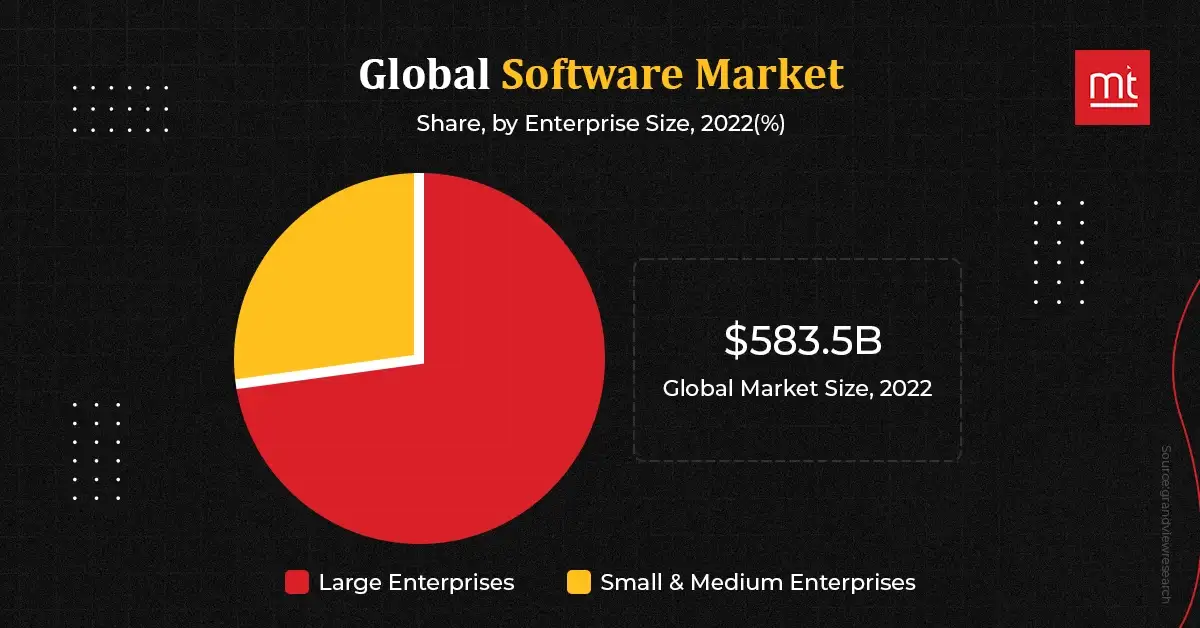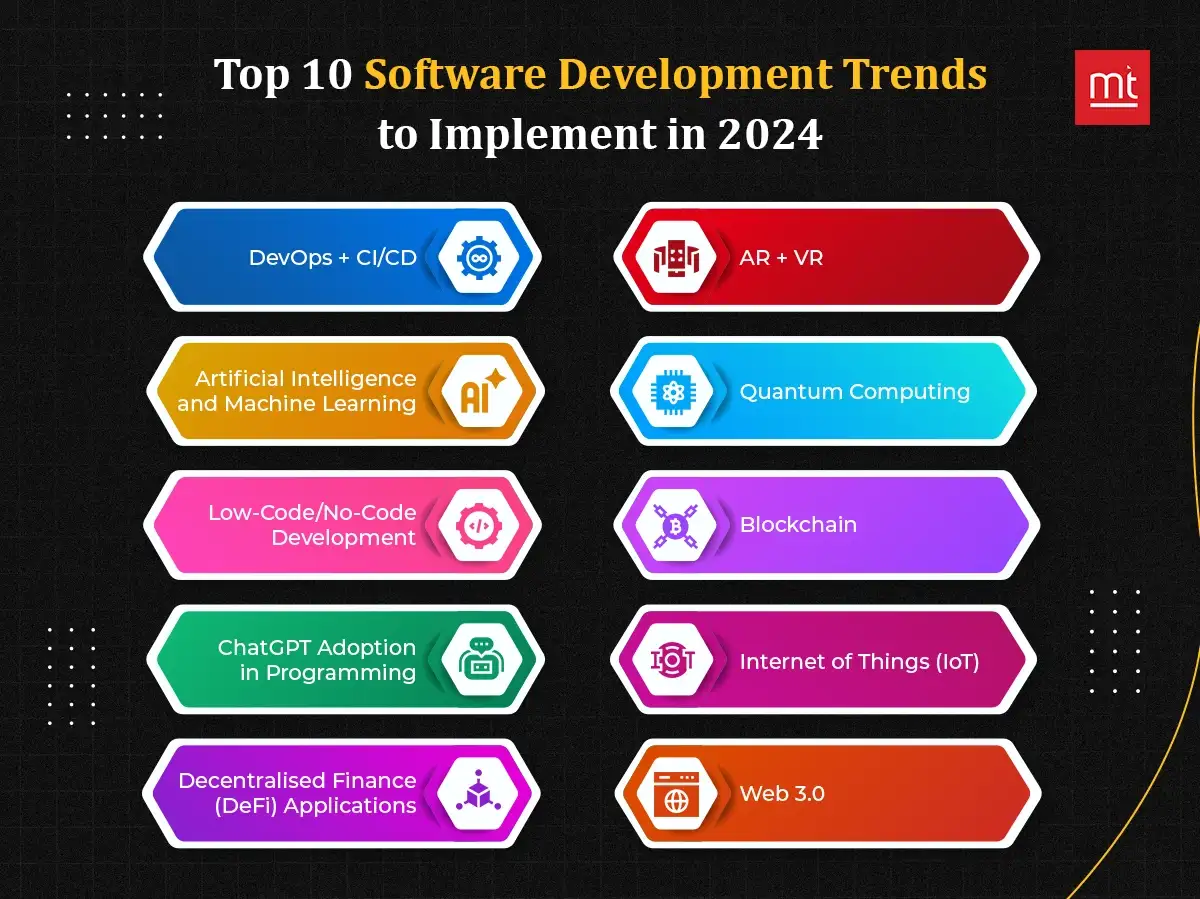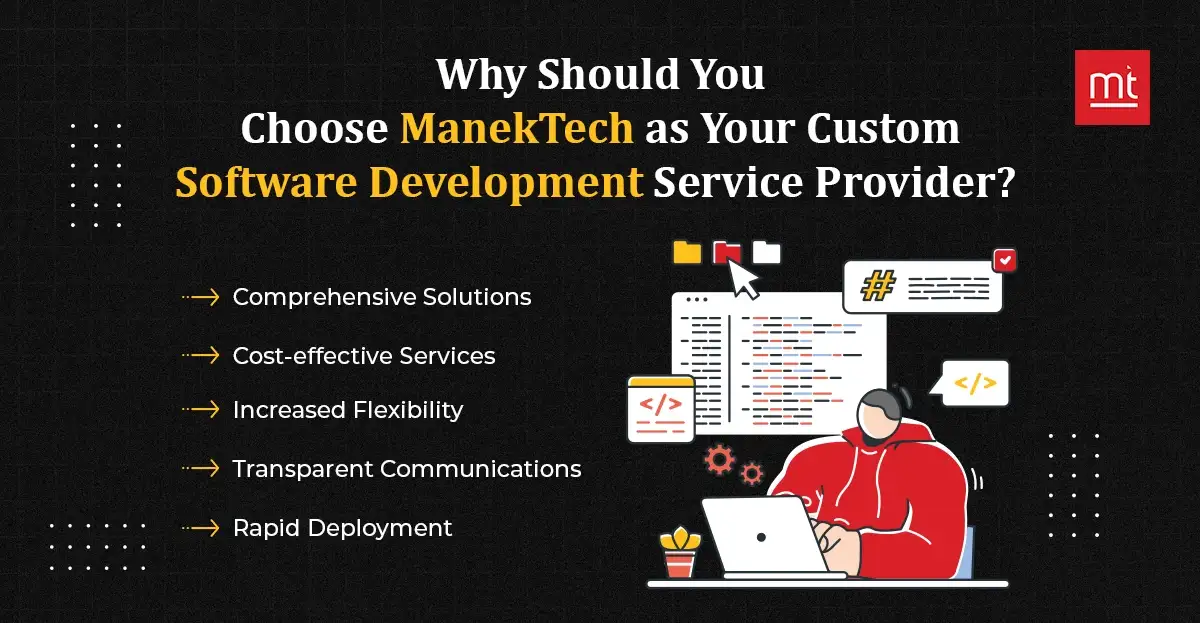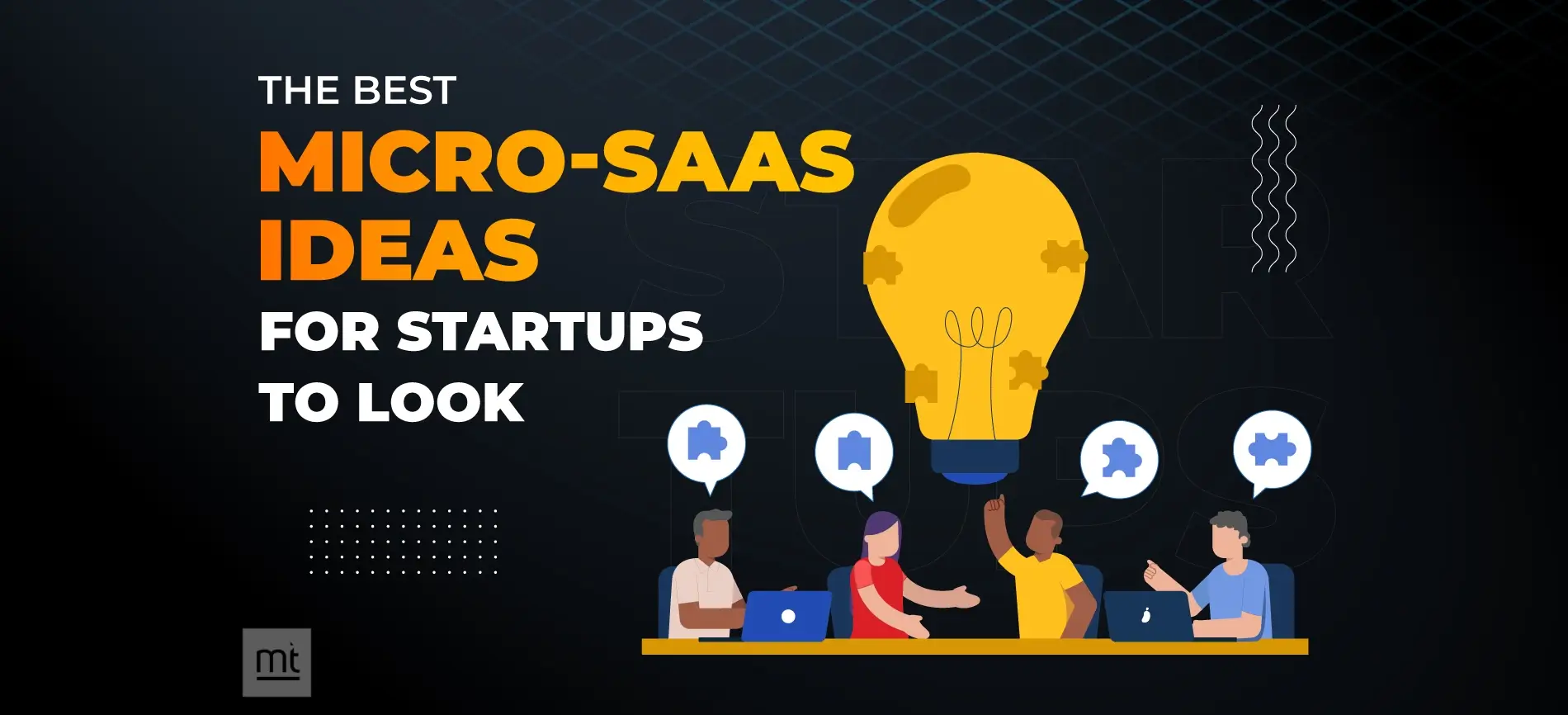Introduction:
Software development, an integral component of the IT industry, is in a state of constant flux driven by shifting mindsets and the pursuit of security. The spending on enterprise software development alone has reached $856.03 billion.
As you navigate this complex and dynamic industry, you must stay abreast with software development trends to foster innovation and reimagine your solutions. Each trend will contribute towards greater agility and increased flexibility.
Leveraging these new-age trends can help adapt and adjust to the changing scenarios for continuous learning and user-centric solutions.
This article will explore each trend in depth. You will learn how all the trends from DevOps to Web 3.0 will revamp the development industry.
An Overview of Software Development Industry
The software development industry is pivotal in enhancing the global economy. From simple solutions to advanced/complex solutions, the realm is continuously evolving to meet the needs of the digital customer.

- The global software market size was valued at $583.47 billion in 2022. It is expected to increase at a CAGR of 11.5% between 2023 and 2030.
- Open-source technology continues to dominate the software development industry. 93% of developers use it to build and deploy their software applications.
- Cloud computing is integral to software development. The cloud applications market size was valued at $133.6 billion in 2021 and it is expected to reach $168.6 in 2025.
Top 10 Software Development Trends to Implement in 2024
Implementing the top software development trends while crafting your solutions can ensure robust and innovative solutions. Here we will discuss the top trends in detail.

#1. DevOps + CI/CD
DevOps blends with Continuous Integration/Continuous Deployment to foster innovation via collaboration. DevOps development service breaks down the silos to extend collaborative development for efficient and streamlined processes.
This integration can automate several parts of the development lifecycle, thus reinventing the traditional development landscape.
CI pipeline assures the developer of integrating the code changes into the shared repository through automated workflows. You don’t need to integrate it manually, which ensures early bug detection and fixes. The CI pipeline can help enhance the quality of your codebase.
Continuous deployment aims to accelerate the delivery process to ensure reliability and stability in the production environment. It can reduce errors and release stable software versions.
When this automation combines with DevOps, it introduces a cultural shift in the organisation. You can use the trio of communication, collaboration and automation to improve insights, share responsibilities and maintain consistency. You can also introduce the feedback loops for more user-centric development.
This combination also alerts the businesses and development teams about the user’s pain points. You get more real-time visibility into your business and shop-floor processes. You can use the data to create a holistic transformation.
- The convergence of DevOps with CI/CD pipelines grants development-to-deployment automation. You can reduce manual intervention, thus ensuring frequent and faster releases.
- The collaborative culture between the development and operations teams can facilitate seamless communication, faster resolutions and efficient systems. You can use the apt tools and technologies for the best outcomes.
- You can ensure reliability and consistency by automating the deployment pipeline. This would ensure stable releases and high-quality software solutions.
- DevOps allows you to allocate and use the resources efficiently for scalability and cost-efficiency
- As the CI/CD pipelines cater to feedback loops, you get real-time insights into the app’s performance. Moreover, you have a complete understanding of your user’s pain points and experiences. This helps address and resolve the issues faster.
#2. Artificial Intelligence and Machine Learning
Artificial Intelligence and Machine Learning have promised to reinvent the application design-to-launch landscape. It will help developers move beyond the traditional development methods to introduce a more personalised, automated and intelligent lifecycle.
According to the AI ML development company, this combination has set the pace for automating repetitive tasks. From code generation to pattern analysis, it helps gather insights to build a more optimised and legible codebase.
You can reduce syntax errors, design issues and other possible problems with AI technology. The algorithms can also help you identify potential issues and eliminate performance bottlenecks. It will ensure proactive resolution to deliver stable software.
You can also use the AI-based tools for the exceptional testing process. It can help you plan the test cases, and ensure comprehensive test coverage and adaptive strategies. Intelligent automation can ensure an adaptive and responsive CI/CD pipeline.
This combination also fosters intelligent coding and insight-backed decision-making.
- You can automate diverse repetitive tasks such as feature selection and data preprocessing for efficient and functional development. This automation will expedite development, reducing the errors
- You can use predictive analytics to study the user’s patterns and determine issues/bottlenecks in advance. This would help eliminate errors and release high-quality solutions
- You can optimise the testing process by defining the test case strategy and including appropriate test case selection. It will help you ensure complete test coverage and efficient testing.
- AI can help ensure adaptive and responsive deployment strategies. You can use the historical data and relevant parameters to optimise the performance and enhance resource allocation.
- It ensures efficient collaboration for better code generation and efficient codebase creation.
#3. Low-Code/No-Code Development
Low-code or no-code development platform have democratised the app development process. It offers a more visual and engaging approach to creating the apps. You don’t need to possess technical expertise to leverage these apps and transform your idea into visual software.
The tools can reduce your dependency on traditional software development teams. Moreover, the visual interface combined with pre-built components allows you to quickly assemble an application and deliver it.
These tools are great for validation of the app idea. As speed to market is key in ensuring success, these tools can help businesses with rapid app development.
These tools can foster collaboration between the different app development stakeholders. This ensures you take a holistic development approach. The collaborative environment allows teams to complement each other and deliver high-quality software.
These platforms ensure flexibility and scalability. The rapid iterations and adaptable landscape offer businesses a competitive edge.
- These development platforms ensure you can quickly assemble the software solutions via visual interfaces. This would help you validate the app in the target market and build a relevant solution.
- These tools can be used by people possessing diverse technical understanding, including SMEs and regular analysts. It reduces their reliance on a software development team in the early stages
- The different stakeholders for the software solution can collaborate, communicate and ensure the app is aligned with the user’s requirements
- You can address the skill and resource shortage with these tools that don’t need extensive coding or skilled experts
- It is agile and flexible, thus allowing you to rapidly respond to the changing tech dynamics.
#4. ChatGPT Adoption in Programming
ChatGPT technology in programming is set to revolutionise the software development lifecycle. This advanced tech can offer real-time code suggestions and development assistance. Your developers can gain help with problem-solving via this technology.
The technology trend will offer contextual code suggestions. Your developers can connect with the technology using natural language to get code suggestions and possibilities. It will provide snippets that can bolster the coding efforts and accelerate development.
Adoption of ChatGPT will democratise programing and reduce the entry barriers. Moreover, the intelligent code completion and error finding features will enhance the quality of the codebase. You can also initiate collaborative coding efforts for a legible and experiential codebase.
The technology is abreast with current tech trends, framework best practices and tools for development. Thi ensures efficient development of modern code.
- The technology trend can help developers connect in natural language to ask queries. ChatGPT will share contextual code snippets to increase the developer’s productivity
- The intelligent code guidance and incredible suggestions to the codebase ensures low barriers to enter the programming realm. People with minimal tech experience can code
- The technology continuously learns from the data available to update the best practices and frameworks. It will ensure smooth and efficient coding.
- As the developers add ChatGPT to their workflow, they can gain on-the-go assistance regarding coding. This would help with debugging and code optimization. Eventually, your developers can release legible codebases
- The tool is pivotal in knowledge sharing and learning. It can educate the freshers and new developers with detailed explanations and insights for faster code development.
Portfolio: Waybill Tracking Software
#5. Decentralized Finance (DeFi) Applications
Decentralized Finance will transform the traditional financial services and systems. It leverages smart contract and Blockchain technologies that enable decentralized platforms. You can use this to deliver financial services minus the intermediaries.
This new tech trend will democratize access to financial services. the decentralized networks will help the different products such as trading, lending and others to move beyond the traditional geographical boundries. As a result, the financial services will be available in unbanked as well as underbanked segments.
Smart Contracts will automate the financial agreements, while enforcing it without the intermediaries. This would reduce the transaction cost and increase the speed of financial operations. As the system is decentralized, it eliminates the risks of single point failure in the financial landscape.
This platform will distribute the data over a node network, thus mitigating all risk types. You can use this technology for more inclusive, transparent and innovative financial services globally.
- Using DeFi technologies, you can democratise financial services. This allows people across the globe, including those from unbanked segments, to access the services
- As the smart contract is used to automate, regulate and enforce the financial agreements, you will notice transparent and efficient financial systems.
- The democratized network reduces the risk of singlepoint failure. It also ensures reduced susceptibility to disruptions caused by failures in the system as the nodes are decentralized.
- This technology fosters collaboration and interoperability to ensures smooth integration of services. it can also contribute towards a dynamic ecosystem that ensures innovation.
#6. AR + VR
AR app development and VR app development will merge to offer more interactive and immersive experiences. It will transform the software development industry by extending an innovative canvas for interface design. You can introduce these technologies to enhance the user’s interaction with the digital content on the website or application.
This technology can help developers translate the 2D interfaces into spatial 3D environments for a more engaging and intuitive user experience. This will open new avenues for interaction and responsive communication.
From training to simulation, this software development trend will extend numerous opportunities in the virtual space. You can use the trend to add a more cost-effective and scalable training solution.
This trend will improve the communication and collaboration between key stakeholders. Moreover, developers can use the technology to incorporate spatial audio and realistic physics to enhance the interactions.
- The two technologies will blend to offer more immersive and interactive user experiences. The users can interact seamlessly within the 3D spaces
- You can use it to simulate the environments and offer training. This is particularly useful in the medical, aviation and manufacturing industries
- Move beyond traditional development to introduce realistic connections and dynamic interactions for better engagement
- You can use spatial computing to connect your digital and physical worlds seamlessly. It will allow you to add natural and intuitive interactions for increased engagement
- The collaboration can help create virtual spaces for real-time communication. It will also help with extensive cooperation and communication.
#7. Quantum Computing
Quantum computing has promised to transform the way developers and businesses approach problem solving and computation. This technology leverages Quantum mechanics principles to perform the high-end computations that were a limitation for the traditional computers and methods.
It will impact all aspects of technology, including cryptography and Machine Learning. It is set to reinvent the development methodology by solving specific problems faster than traditional methods. Additionally, they can perform the tasks such as factorization and large database searches efficiently, which will impact the algorithm creation.
Quantum parallelism allows you to consider multiple solutions for the same problem at an extraordinary speed. This technology can help deliver high-quality Quantum algorithms that improve data learning and insight generation. It will increase the opportunities for advancement in AI and data analysis.
- Quantum computers can solve problems faster than their traditional counterparts. this would help with functions such as large database searches and factorization.
- As Quantum bits and qubits can exist in multiple states, they can explore infinite solutions to a single algorithm in seconds. This would help solve complex issues and extend computational excellency
- This technology will advance cryptographic methods that can ensure better data security and enhance the safety of transactions
- It can advance the Machine Learning processing and tasks to create sophisticated models and drive quality insights. This would help your business with decision making.
#8. Blockchain
Blockchain development will transform the traditional software landscape with decentralised and tamper-resistant methodologies. Blockchain is basically a distributed ledger technology developed to ensure secure and safe record keeping. It can protect and transform several industries by enhancing their security, and data management to foster trust and credibility.
Blockchain will reinvent the software development landscape by extending data integrity. This means the data cannot be altered once it has entered the Blockchain realm. Smart Contracts are an integral part of Blockchain technology. You can use these programmable contracts for automated contracts, and streamlined operations.
It eliminates the need for intermediaries to ensure quick and efficient processes. The tokenization features allow you to transform the way assets are exchanged on virtual platforms. It can extend accountability, which is key to building credibility.
- The technology has introduced decentralised data management, which eliminates central data authority. It will reduce the risk of failure and ensure better trust among stakeholders
- As the data is immutable, you can assure high levels of data integrity. This would help enhance the accuracy of data and facilitate trust
- You can use the smart contracts for streamlined processes and automated enforcement, which reduces the chances of errors
- Tokenization can help improve fractional ownership and enhance DeFi services. it can make financial systems inclusive and accessible to all people and geographies.
Portfolio: Marine Port Management System
#9. Internet of Things (IoT)
The Internet of Things has already started to transform the software development realm via connected devices and smart ecosystems. This trend has refined the user’s approach towards application design, data management and user interactions.
The incredible connected device network will ensure swift development and smooth app development. IoT app development will ensure a seamless flow of data between diverse devices, including smart home devices and wearables.
The idea is to harness the world of connected devices and immense data to provide smart and innovative solutions. Edge computing combined with IoT development can help leverage the data for efficient operations. It can reduce the latency and deliver optimised applications.
As several interconnected devices are operating in this realm, it has become crucial for businesses to consider the various security measures to protect the data. This would include encryption and secure authentications. This way you can leverage the technology to protect against cyber threats.
Additionally, you must ensure a proactive approach towards UX design while planning IoT applications. You must unify the environment and offer a more intuitive design/development experience.
- IoT development can ensure swift communication and seamless data exchange between the devices and ecosystems. This would foster efficient and intelligent systems that are collaborative
- You can enhance efficiency and automate numerous tasks via interconnected device culture. This would help monitor the systems, implement effective resource utilisation and optimise tasks with minimal latency
- You can leverage the data from diverse sources to gather valuable insights that can help with recommendations and intelligent decisions. You can also use the patterns developed over a specific period to improve the system’s performance.
- It helps with remote monitoring, asset management and device control for better presence and reduced downtime.
#10. Web 3.0
Web 3.0 is set to usher in decentralised and user-centric experiences. It has better data control, which results in transparent and reliable interactions. Blockchain technology is pivotal in the success of Web 3.0 technology.
Decentralization is at the core of this technological advancement. It will help create decentralized applications (dApps) that ensure the data is distributed across nodes. This would increase security, mitigate failure risks and offer users complete control of their data.
Smart contracts are crucial for seamless operation within the Web 3.0 realm. You can use it to streamline processes and ensure decentralized governance. This technology prioritises ownership of data combined with privacy. You can offer users great control over their data, thus fostering credibility and trust.
Web 3.0 is interoperable, which means it facilitates seamless interactions. This would help build a thriving and collaborative digital ecosystem.
- Decentralization is at the core of Web 3.0 technologies. This ensures distributed data that empowers users with greater control and eliminates the risk of failure
- Smart contracts can ensure better processes, and automated contracts and make the financial systems reliable and efficient
- You get better control of the data. The decentralized systems will prioritize user-centric models that allow them to access and customise their data. It ensures a safe and transparent environment for their data.
- Web 3.0 promotes interoperability via standard protocols and practices. It allows you to create more connected systems and collaborative solutions. It can break down the platform silos and allow the services or software to communicate effortlessly.
Why Should You Choose ManekTech as Your Custom Software Development Service Provider?

1. Comprehensive Solutions
ManekTech has a rich history and a proven track record of delivering successful and all-inclusive solutions for diverse industries. We have continuously delivered to meet the client’s requirements and objectives. Our customer-centric attitude has helped us attain an edge over the competition.
2. Cost-effective Services:
Despite the best customizations, we offer competent pricing strategies for your application. We aim to prioritise quality and user-centric features. We ensure aligning your app development with your budget to deliver capable and functional solutions.
3. Increased Flexibility
Our team can adapt to the changing business requirements and development landscape. We offer solutions that remain relevant and effective for a longer while. You can choose us for adaptable and seamless experiences.
4. Transparent Communications
Our open and clear communication protocols ensure you are aware of the app’s progress. This transparency fosters trust and collaboration that helps incorporate adjustments and continuous improvements. We can deliver a more aligned app with this approach.
5. Rapid Deployment
We value your time and ensure an approach that helps you accelerate the time to market. Our team will deliver the results without compromising on the app’s quality. Moreover, we ensure a more reliable development approach that extends a competitive edge.
Conclusion
Software development trends such as no-code/low-code development and Blockchain will democratise the development realm. IoT app development combined with AI+ML and AR+VR will create more immersive and user-centric experiences.
These technologies can enhance the intelligent code, make your applications smarter and blend the virtual and real environments.
It is crucial to incorporate these trends into your tech landscape for innovative and future-proof applications. ManekTech will partner with you as a software development partner to deliver comprehensive and cost-effective solutions.
Our proven track record and unmatched flexibility ensure rapid development while embracing cutting-edge technologies. As your strategic ally, we will help you gain a competitive edge with your custom software solution.
Connect with our team to discuss the software feasibility and translate your idea into a reliable solution.
FAQ About Software Development Trends
1. What are the latest and emerging trends in software development?
Ans: The latest and emerging software development trends include increased adoption of low-code/no-code platforms, AI-ML integration, IoT app development and convergence of DevOps with CI/CD pipelines.
2. Which is the least popular technology for software development?
Ans: There is no specific answer to this as it can evolve with time. however, obsolete technologies or software solutions with minimal support can be added to this list. The legacy programming languages and systems are examples of outdated systems that are least popular in the current development realm.
3. What are the future trends in software development?
Ans: The future trends for software development include Blockchain, Web 3.0, cybersecurity and edge computing. You can also add Quantum computing to this list.
4. How will these trends affect software development in 2024?
Ans: These development trends will impact the core security, seamlessness of transactions and developer’s efficiency. It can also reduce the risks, promote transparency and ensure more productive life cycles. Eventually, the trends can benefit the developers with innovative solutions.
5. What are the benefits of adopting modern software development trends?
Ans: You must adopt modern software development trends to improve efficiency and speed in the development processes. It can enhance security, foster intelligent code development and personalise the applications. You can promote scalable and innovative solutions with the new trends.
About Author
Subscribe to Our Newsletter!
Join us to stay updated with our latest blog updates, marketing tips, service tips, trends, news and announcements!





















